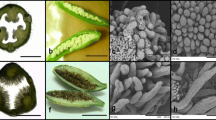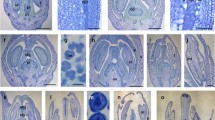Abstract
Roses are known to produce seeds with high concentrations of abscisic acid (ABA), both in the pericarp and in the testa tissues of the seed coat. No studies on roses have documented embryo morphological differentiation or the concentration of ABA in the embryo, which is known to inhibit premature germination. In this study, hip and seed growth of two hybrid roses were characterised from 3 to 60 days after pollination (DAP). An increase of about five times the hip mass at 3 DAP was necessary to obtain fully developed seeds. Fully developed embryos were found at 15 DAP and completely developed seeds at 30 DAP. The same pattern of hip mass increase was shown in both genotypes. In parallel, quantification of ABA in the developing embryos was carried out by ELISA. An exponential decay in ABA concentration was found in embryos of both genotypes, with basal levels (<0.5 pmol mg−1) registered at 30 DAP. These changes in ABA, during the embryo development, could be used to formulate time points for embryo rescue and understanding of the pollination to seedling stage.




Similar content being viewed by others
References
Ali-Rachedi S, Bouinot D, Wagner MH, Bonnet M, Sotta B, Grappin P, Jullien M (2004) Changes in endogenous abscisic acid levels during dormancy release and maintenance of mature seeds: studies with the Cape Verde Islands ecotype, the dormant model of Arabidopsis thaliana. Planta 219:479–488
Barton LV (1961) Experimental seed physiology at the Boyce Thompson Institute. Proc Int Seed Test Assoc 26:561
Baskin JM, Baskin CC (2004) A classification system for seed dormancy. Seed Sci Res 14:1–16
Bewley JD (1997) Seed germination and dormancy. Plant Cell 9:1055–1066
Bewley JD, Black M (1994) Seeds: physiology of development and germination. Plenum, New York
Bies-Etheve N, Gaubier-Comella P, Debures A, Lasserre E, Jobet E, Raynal M, Cooke R, Delseny M (2008) Inventory, evolution and expression profiling diversity of the LEA (late embryogenesis abundant) protein gene family in Arabidopsis thaliana. Plant Mol Biol 67:107–124
Blintsov AN, Gusakovskaya MA (2006) Immunoenzyme method for differential assay of free and bound ABA. Russ J Plant Physl 53:407–412
Bo J, Huiru D, Xiaohan Y (1995) Shortening hybridization breeding cycle of rose—a study on mechanisms controlling achene dormancy. Acta Hort 404:40–47
Burger DW, Liu L, Zary KW, Lee CI (1990) Organogenesis and plant regeneration from immature embryos of Rosa hybrida L. Plant Cell. Tissue Organ Cult 21:147–152
Cadman CS, Toorop PE, Hilhorst HW, Finch-Savage WE (2006) Gene expression profiles of Arabidopsis Cvi seeds during dormancy cycling indicate a common underlying dormancy control mechanism. Plant J 46:805–822
de Vries DP, Dubois LAM (1983) Pollen and pollination experiments. X. The effect of repeated pollination on fruit-and seed set in crosses between the hybrid tea-rose CVS. Sonia and Ilona. Euphytica 32:685–689
Dekkers BJ, Schuurmans JA, Smeekens SC (2008) Interaction between sugar and abscisic acid signalling during early seedling development in Arabidopsis. Plant Mol Biol 67:151–167
Dubois LAM, de Vries DP (1986) The effect of gibberellins A4 + 7 on fruit set and seed set in unpollinated and pollinated ‘Sonia’ roses. Plant Growth Regul 4:75–80
Finch-Savage WE, Leubner-Metzger G (2006) Seed dormancy and the control of germination. New Phytol 171:501–523
Gudin S (1994) Embryo rescue in Rosa hybrida L. Euphytica 72:205–212
Gudin S, Mouchotte J (1995) Integrated research in rose improvement—a breeder’s experience. Acta Hort 424:285–291
Hoecker U, Vasil IK, McCarty DR (1995) Integrated control of seed maturation and germination programs by activator and repressor functions of Viviparous-1 of maize. Gene Dev 9:2459–2469
Hong CY, Hsu YT, Tsai YC, Kao CH (2007) Expression of ASCORBATE PEROXIDASE 8 in roots of rice (Oryza sativa L.) seedlings in response to NaCl. J Exp Bot 58:3273–3283
Jackson GAD (1968) Hormonal control of fruit development, seed development and germination with particular reference to Rosa. SCI Monogr 31:127–156
Jackson GAD, Blundell JB (1963) Germination in Rosa. J Hort Sci 38:310–320
Jackson GAD, Blundell JB (1965) Germination of Rosa arvensis. Nature 205:518–519
Jacob Y, Ferrero F (2003) Pollen grains and tubes. In: Roberts AV, Debener T, Gudin S (eds) Encyclopedia of rose science, vol 1. Elsevier Academic Press, Oxford, pp 518–523
Jones G, Wortberg M, Kreissig SB, Bunch DS, Gee SJ, Hammock BD, Rocke DM (1994) Extension of the four parameter logistic model for ELISA to multianalyte analysis. J Immunol Methods 177:1–7
Kanavage AD, Leslie V, Boyer LV, Jude McNally J, John J, Osterhout JJ (2006) Resistance of antivenom proteins to foaming-induced denaturation. Toxicon 47:445–452
Kinoshita N, Berr A, Belin C, Chappuis R, Nishizawa NK, Lopez-Molina L (2010) Identification of growth insensitive to ABA3 (gia3), a recessive mutation affecting ABA signaling for the control of early post-germination growth in Arabidopsis thaliana. Plant Cell Physiol 51:239–251
Kucera B, Cohn MA, Leubner-Metzger G (2005) Plant hormone interactions during seed dormancy release and germination. Seed Sci Res 15:281–307
Lacey EP, Smith S, Case AL (1997) Parental effects on seed mass: seed coat but not embryo/endosperm effect. Am J Bot 84:1617–1620
Le Page-Degivry MT, Bianco J, Barthe P, Garello G (1996) Change in hormone sensitivity in relation to the onset and breaking of sunflower embryo dormancy. In: Lang GA (ed) Plant dormancy: physiology, biochemistry and molecular biology. CAB International, Wallingford, pp 221–231
Mansfield SG, Briarty LG (1991) Early embryogenesis in Arabidopsis thaliana: the developing embryo. Can J Bot 69:461–476
Marchant R, Power JB, Davey MR, Chartier-Hollis J (1994) Embryo rescue for the production of F1 hybrids in English rose. Euphytica 74:187–193
Mohapatra A, Rout GR (2005) Study of embryo rescue in floribunda rose. Plant Cell Tiss Org 81:113–117
Narum SR, Banks M, Beacham TD, Bellinger MR, Campbell MR, Dekoning J, ELZ A, Guthrie CM, Kozfkay C, Miller KM, Moran P, Phillips R, Seeb LW, Smith CT, Warheit K, Young SF, Garza JC (2008) Differentiating salmon populations at broad and fine geographical scales with microsatellites and single nucleotide polymorphisms. Mol Ecol 17:3464–3477
Ogilvie I, Cloutier D, Arnold N, Jui PY (1991) The effect of gibberellic acid on fruit and seed set in crosses of garden and winter hardy Rosa accessions. Euphytica 52:119–123
Pipino L, Van Labeke MC, Mansuino A, Scariot V, Giovannini A, Leus L (2011) Pollen morphology as fertility predictor in hybrid tea roses. Euphytica 178:203–214
Raz V, Bergervoet JHW, Koornneef M (2001) Sequential steps for developmental arrest in Arabidopsis seeds. Development 128:243–252
Roach DA, Wulff RD (1987) Maternal effects in plants. Annu Rev Ecol Syst 18:209–235
Rogiers SY, Holzapfel BP, Smith JP (2011) Sugar accumulation in roots of two grape varieties with contrasting response to water stress. Ann Appl Biol 159:399–413
Schmid B, Dolt C (1994) Effects of maternal and paternal environment and genotype on offspring phenotype in Solidago altissima L. Evolution 48:1525–1549
Taiz L, Zeiger E (2006) Plant physiology, 4th edn. Sinauer Associates Inc., Sunderland
Thiede DA (1998) Maternal inheritance and its effect on adaptive evolution: a quantitative genetic analysis of maternal effects in a natural plant population. Evolution 52:998–1015
Tillberg E (1983) Levels of endogenous abscisic acid in achenes of Rosa rugosa during dormancy release and germination. Physiol Plantarum 58:243–248
Ueda Y (2003) Seed Maturation and Germination. In: Roberts AV, Debener T, Gudin S (eds) Encyclopedia of rose science. Elsevier Academic Press, Oxford, pp 623–626
Yambe Y, Hori Y, Takeno K (1992) Levels of endogenous abscisic acid in rose achenes and leaching with activated charcoal to improve seed germination. J Jpn Soc Hort Sci 61:383–387
Yu H, Chen X, Hong YY, Wang Y, Xu P, Ke SD, Liu HY, Zhu JK, Oliver DJ, Bin Xiang CB (2008) Activated expression of an Arabidopsis HD-START protein confers drought tolerance with improved root system and reduced stomatal density. Plant Cell 20:1134–1151
Zlesak DC (2006) Rose Rosa x hybrida. In: Anderson NO (ed) Flower breeding and genetics: issues, challenges and opportunities for the 21st century. Springer, Dordrecht, pp 695–738
Acknowledgments
A PhD scholarship for the first author was provided by Ghent University (BOF 08/FJD/010). The authors wish to thank ir. Annelies Christiaens for her contribute to the ABA quantification analysis.
Author information
Authors and Affiliations
Corresponding author
Rights and permissions
About this article
Cite this article
Pipino, L., Leus, L., Scariot, V. et al. Embryo and hip development in hybrid roses. Plant Growth Regul 69, 107–116 (2013). https://doi.org/10.1007/s10725-012-9752-9
Received:
Accepted:
Published:
Issue Date:
DOI: https://doi.org/10.1007/s10725-012-9752-9




